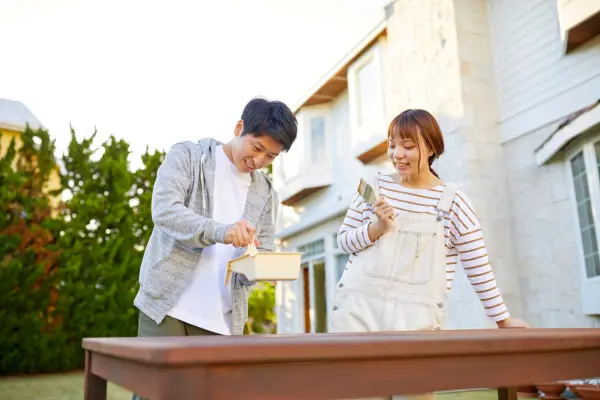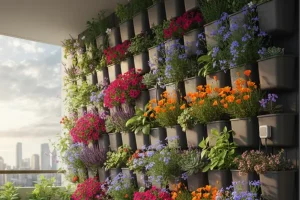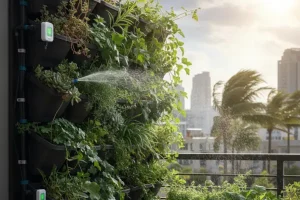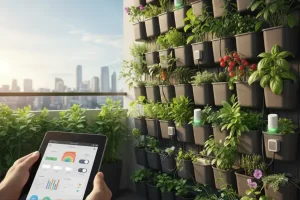A lack of space doesn’t have to stop you from growing your own food. Vertical gardens make it possible to turn a balcony, patio, or even a small wall into a productive garden. The best part? You don’t need expensive equipment. With a few supplies and a free weekend, you can build your own low-cost vertical system and start harvesting fresh greens, herbs, and even strawberries right at home.
In this article, we’ll walk through several DIY vertical garden designs that are affordable, easy to build, and customizable to your space.
Why DIY Vertical Gardens Matter
Buying a pre-made vertical garden system can cost anywhere from $200 to over $1,000. While those systems are convenient, they aren’t the only option. Building your own offers several advantages:
- Significant cost savings
- Custom sizes and designs
- A fun, hands-on project
- The satisfaction of growing food in a system you built yourself
Even if you’re a beginner, these weekend projects are straightforward and require only basic tools.
DIY Option 1: PVC Pipe Tower
Materials Needed:
- 4–6 ft PVC pipe (4–6 inches in diameter)
- Net cups or planting cups
- Submersible water pump (for hydroponic version)
- Drill and hole saw attachment
- Growing medium (clay pebbles, coco coir, or similar)
How It Works:
Drill evenly spaced holes along the pipe, insert net cups, and plant seedlings. For hydroponic use, a pump circulates water through the pipe; for soil, simply fill the pipe with lightweight potting mix.
Cost: $40–$60 depending on pump size.
Best Plants: Lettuce, basil, spinach, and small herbs.
DIY Option 2: Wooden Pallet Wall Garden
Materials Needed:
- One reclaimed wooden pallet
- Landscape fabric
- Staple gun
- Potting mix
How It Works:
Stand the pallet upright, attach landscape fabric to the back and sides, then fill with soil. Each pallet section becomes a pocket for planting herbs, flowers, or leafy greens.
Cost: $20–$40 (pallets are often free).
Best Plants: Herbs, leafy greens, and shallow-rooted flowers.
DIY Option 3: Hanging Bottle Garden
Materials Needed:
- Empty plastic bottles (1–2 liters)
- String or wire
- Scissors or utility knife
- Potting mix
How It Works:
Cut bottles in half, poke drainage holes, and stack them vertically by threading string or wire through each side. Fill with soil and plant small herbs or leafy greens.
Cost: Nearly free if you already have bottles.
Best Plants: Basil, mint, parsley, and small lettuce varieties.
DIY Option 4: Stackable Buckets
Materials Needed:
- 5-gallon buckets
- Drill for planting holes
- Potting mix or hydroponic setup
- Optional: pump for automated watering
How It Works:
Drill holes in the sides of buckets for plant pockets, then stack them securely. Water flows down through each level, reaching all plants.
Cost: $25–$50 depending on the number of buckets.
Best Plants: Strawberries, kale, and leafy greens.
Cost Comparison Table
| DIY Option | Estimated Cost | Difficulty Level | Best For |
| PVC Pipe Tower | $40–$60 | Moderate | Compact herbs and greens |
| Wooden Pallet Garden | $20–$40 | Easy | Patio or balcony use |
| Hanging Bottle Garden | Free–$10 | Easy | Ultra-low budget setups |
| Stackable Buckets | $25–$50 | Easy–Moderate | Strawberries and greens |
Tips for Success with DIY Systems
- Start with hardy plants such as lettuce, basil, or mint.
- Ensure proper drainage in every design to avoid root rot.
- Place your garden in a sunny location or use grow lights indoors.
- Use lightweight, well-draining potting mixes if working with soil.
- Consider painting or decorating your structure to match your space.
Common Mistakes to Avoid
- Skipping drainage holes: This leads to soggy soil and root rot.
- Using untreated wood in pallets: Untreated wood rots quickly outdoors. Look for heat-treated (HT) pallets instead.
- Overloading plants: Start small and let your system stabilize before planting every pocket.
- Ignoring weight: When filled with soil and water, vertical systems can be heavy. Ensure your structure is secure and supported.
FAQs
Q: Which DIY system is best for beginners?
The wooden pallet garden is the simplest and most forgiving option. It requires minimal tools and works well outdoors.
Q: Can these systems be used indoors?
Yes, but you’ll need trays to catch drips and grow lights if natural sunlight is limited. The PVC pipe tower is especially suited for indoor spaces.
Q: Do I need a pump for all these systems?
No. Pumps are only necessary if you want a hydroponic setup. Pallet, bottle, and bucket gardens can work with soil and manual watering.
Q: How long do these DIY systems last?
- PVC pipe towers can last for years.
- Pallet gardens may last 2–3 seasons before the wood degrades.
- Bottle gardens are temporary but easy to replace.
- Buckets last several years if cleaned and stored properly.
Next Steps & Related Reading
Once your DIY system is set up, the next step is consistency. Consider reading Automating Your Vertical Garden: Timers, Pumps & Controllers to learn how to reduce manual watering and make your garden more self-sufficient.
For seasonal adjustments, check out Seasonal Maintenance Checklist for Vertical Growing Systems so your setup continues to thrive throughout the year.
Conclusion
Building a vertical garden doesn’t need to be expensive or complicated. With just a weekend and a few affordable materials, you can create a productive system tailored to your space.
Whether you choose a PVC tower, pallet garden, bottle setup, or stackable buckets, the key is to start small, learn as you go, and enjoy the satisfaction of harvesting fresh produce from a system you built yourself.
Which DIY vertical garden idea are you most excited to try this weekend?




